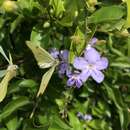en
names in breadcrumbs


La Melete lycimnia ye una especie de caparina, de la familia de les piérides, que foi descrita orixinalmente col nome de Papilio lycimnia, por Cramer, en 1777, a partir d'exemplares procedentes de Surinam.[2][1]
La Melete lycimnia ta distribuyida ente les rexones neotropical y neártica, y foi reportada en 12 países.[3][4][5][6][7]
Les canesbes de Melete lycimnia aliméntense de plantes de les families Santalaceae y Loranthaceae. Ente les plantes güéspedes reportaes atópense Phoradendron quadrangulare, Phthirusa stelis, Struthanthus dichotrianthus.[8][9][10]
La Melete lycimnia ye una especie de caparina, de la familia de les piérides, que foi descrita orixinalmente col nome de Papilio lycimnia, por Cramer, en 1777, a partir d'exemplares procedentes de Surinam.
Melete lycimnia, the common melwhite, primrose flag or lycimnia white flag, is a butterfly in the family Pieridae. It is found from Texas in the United States to Bolivia. The habitat consists of lowland rainforests.[2]
The wingspan is 52–56 mm (2.0–2.2 in).[3] The appearance of the adults depends on the subspecies and ranges from a white ground colour, narrow black borders, and a yellow spot at the base of the hindwings (M. l. peruviana) to primrose yellow, with wide brown borders (M. l. lycimnia). In all subspecies, females are more yellowish.[2]
The larvae probably feed on Loranthaceae species.[2]
The following subspecies are recognised:[1]
Melete lycimnia, the common melwhite, primrose flag or lycimnia white flag, is a butterfly in the family Pieridae. It is found from Texas in the United States to Bolivia. The habitat consists of lowland rainforests.
The wingspan is 52–56 mm (2.0–2.2 in). The appearance of the adults depends on the subspecies and ranges from a white ground colour, narrow black borders, and a yellow spot at the base of the hindwings (M. l. peruviana) to primrose yellow, with wide brown borders (M. l. lycimnia). In all subspecies, females are more yellowish.
The larvae probably feed on Loranthaceae species.
Melete lycimnia es una especie de mariposa, de la familia de las piérides, que fue descrita originalmente con el nombre de Papilio lycimnia, por Cramer, en 1777, a partir de ejemplares procedentes de Surinam.[2][1]
Melete lycimnia está distribuida entre las regiones Neotropical, Neártica y ha sido reportada en 12 países. [3][4][5][6][7]
Las larvas de M. lycimnia se alimentan de plantas de las familias Santalaceae y Loranthaceae. Entre las plantas hospederas reportadas se encuentran Phoradendron quadrangulare, Phthirusa stelis, Struthanthus dichotrianthus.[8][9][10]
Melete lycimnia es una especie de mariposa, de la familia de las piérides, que fue descrita originalmente con el nombre de Papilio lycimnia, por Cramer, en 1777, a partir de ejemplares procedentes de Surinam.
Melete lycimnia is een vlindersoort uit de familie van de Pieridae (witjes), onderfamilie Pierinae.
Melete lycimnia werd in 1777 beschreven door Cramer.[1]
Bronnen, noten en/of referenties